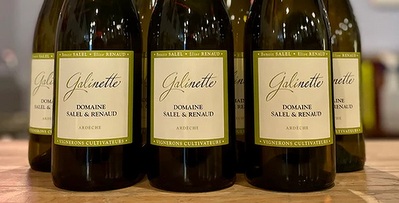 Salel & Renaud Wines – Organic and biodynamic
Salel & Renaud Wines – Organic and biodynamic
Salel & Renaud may be the most esoteric and “academic” of all the French growers that our new importer, Transparent, imports. For years, Elise Renaud and Benoit Salel worked in the vines and cellars under some of the biggest dogs in Cote Rotie, Hermitage, Provence, and Sancerre before starting their own farm in their native Ardèche. All wines are made by Elise Renaud; all farming is done by her husband, Benoit Salel.
The Ardèche sits on the western banks of the Rhône river and covers an important part of the northern Rhône vineyards while also bridging into the western side of the southern Rhône. Generally speaking, while the AOC-level appellations Saint-Joseph, Cornas, Saint-Peray, Côtes du Vivarais and some Côtes du Rhône vineyards are all located within this region, the IGP-level vineyards are found in the dry, scrubby foothills of the Cévennes mountains and along the river Ardèche valley. The narrow valley of the Rhône is often reserved for the more prestigious AOC wines. The department lies approximately 50km (30 miles) south of Lyon and 100km (60 miles) north of the Mediterranean, between the Rhône river to the east and the Massif Central plateau to the west.
Elise Renaud and Benoit Salel both hail from the Cevennes Ardechoises, where both of their families have tended the vine for many generations. While their elders sold all of their grapes to the local cooperative, Elise and Benoit decided to give it a go, making their own wines from their own vines. The two bought eight acres of vines in the rugged Ardeche region, and the rest is history. They have increased their holdings to 35 acres, and they have converted all of their vineyards over to organics.
Since 2007 Elise Renaud and Benoit Salel have been doing double-duty as ampelographers and archivists, working diligently to find, propagate, and replant old varieties which were once grown in the southern Ardèche. Like many of the more rural areas of France, the region’s indigenous/ancient grape varieties had long since fallen into oblivion. Along with the more familiar varieties that are found in appellations throughout the Rhône region, Elise and Benoit have patiently cultivated varieties such as Chatus, Dureza, Raisaine, and Picardan. For them, these indigenous grape varieties are the soul and identity of the Cévennes Ardéchoises. As Elise and Benoit say, “There is nothing to invent, the future is simply what has been forgotten.”
Their greatest passion is tracking down ancient, pre-phylloxera “heirloom” grape varieties in forests and long-neglected vineyards throughout the Ardèche, then propagating, replanting, and re-introducing them to modern drinkers by way of delicious wines. It’s a decade-long process not for the lazy or faint of heart, but the results are stunning: Light/medium-bodied, but hauntingly floral, meaty, and tooth-staining reds from grapes like Dureza and Chatus, plus waxy, saline, and exotically aromatic whites from the Raisaine and Picardan grapes — and we would be remiss in not mentioning their electrifying Grenache/Gamay blend “Mescladis” and gorgeously textural Roussanne/Vermentino “Galinette”. Low prices, handsome labels, attention-grabbing wines, and an exciting back-story — do not miss Salel & Renaud!
Their wines are brand new to the United States, and their La Galinette Blanc is my idea of the perfect white wine. What I like most about this wine is its elegance; White Rhones can often be a bit “clunky,” but this one is fresh, zesty, and precise. At just 12.5% alcohol, this blend of equal parts Vermentino and Roussanne shines with both Southern and Northern Rhone character. The Roussanne contributes heady scents and flavors of peach, lemon, and honeysuckle, while the Vermentino adds acidity along with notes of pink grapefruit, citrus zest, and herb. All in all, this all adds up to create a joyful and delicious drinking experience. This is a wine that would be great served with the classic Thanksgiving feast, but I don’t think we’ll have any left by the time Turkey Day gets here. Thus, enjoy now with roasted chicken and root vegetables or richer, oilier fish and seafood dishes. Or skip the food altogether and just drink this one with a good friend or loved one.


